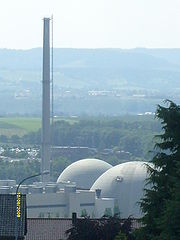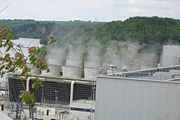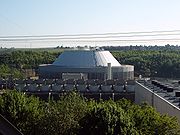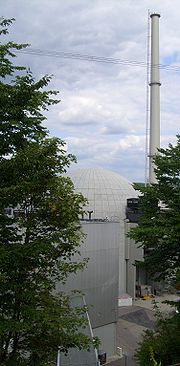
Neckarwestheim Nuclear Power Plant
Encyclopedia

Nuclear power plant
A nuclear power plant is a thermal power station in which the heat source is one or more nuclear reactors. As in a conventional thermal power station the heat is used to generate steam which drives a steam turbine connected to a generator which produces electricity.Nuclear power plants are usually...
in Neckarwestheim
Neckarwestheim
Neckarwestheim is a municipality with 3524 inhabitants in the Heilbronn district, Baden-Württemberg, in south-west Germany. It is located on the Neckar river and is well known as the location of a nuclear power station.-Geographical position:...
, Germany
Germany
Germany , officially the Federal Republic of Germany , is a federal parliamentary republic in Europe. The country consists of 16 states while the capital and largest city is Berlin. Germany covers an area of 357,021 km2 and has a largely temperate seasonal climate...
. It is sometimes abbreviated GKN (for ). It is operated by EnBW Kernkraft GmbH.
GKN 1
The nominal electrical power of block I, in service since 1976, is 840 megawatts. The 50 Hz three phase ACAlternating current
In alternating current the movement of electric charge periodically reverses direction. In direct current , the flow of electric charge is only in one direction....
power is 567 megawatts and for the 16.7 Hz traction current power 174 MW. The traction current generator is the world's largest electrical generator
Electrical generator
In electricity generation, an electric generator is a device that converts mechanical energy to electrical energy. A generator forces electric charge to flow through an external electrical circuit. It is analogous to a water pump, which causes water to flow...
for single phase AC. The generator block 1 is rated 21,000 volt
Volt
The volt is the SI derived unit for electric potential, electric potential difference, and electromotive force. The volt is named in honor of the Italian physicist Alessandro Volta , who invented the voltaic pile, possibly the first chemical battery.- Definition :A single volt is defined as the...
s at a current of 27,000 ampere
Ampere
The ampere , often shortened to amp, is the SI unit of electric current and is one of the seven SI base units. It is named after André-Marie Ampère , French mathematician and physicist, considered the father of electrodynamics...
s, and the traction current generator is rated 14,500 volts and a current of 12,000 amperes. The current produced by the generators is stepped up to 220 kilovolts (three-phase alternating current) and/or 110 kilovolts (traction current) with the machine transformer
Transformer
A transformer is a device that transfers electrical energy from one circuit to another through inductively coupled conductors—the transformer's coils. A varying current in the first or primary winding creates a varying magnetic flux in the transformer's core and thus a varying magnetic field...
s. Block I is the only nuclear power station which produces traction current. Block I was shutdown on March 17, 2011 for a three month moratorium on nuclear power, an announcement on May 30, 2011 named block I as a unit that would not be returning to service.
GKN 2
The nominal electrical power of block 2, in service since 1988, is 1400 megawatts. The generator produces 50 Hz three-phase alternating current with a voltage of 27,000 V and a current of 35,000 amperes. Unlike Unit 1, no dedicated traction current generation takes place, but some of the power produced is converted at the traction current substation. This is transmitted through the 380 kV generator transformer block of the II and the 380 kV-machine transformer of the motor-generatorMotor-generator
A motor-generator is a device for converting electrical power to another form. Motor-generator sets are used to convert frequency, voltage, or phase of power. They may also be used to isolate electrical loads from the electrical power supply line...
sets.

Traction current converter plant
The GKN station also has a 16.7 Hz traction current converter plantTraction current converter plant
A traction substation or traction current converter plant is an electrical substation that converts electric power from the form provided by the electrical power industry for public utility service to an appropriate voltage, current type and frequency to supply railways, trams and/or trolleybuses...
. The traction converter plant at Neckarwestheim, which is situated close to the switchgear of block II, has two identical sets, consisting of a three-phase 50 Hz AC motor with 12 poles and a four pole single phase 16.7 Hz AC synchronous generator. The rated voltage of the three-phase AC asynchronous machine and the traction current machine is 12.5 kV. The set has a length of 17.5 meters and a maximum width of 7 meters. The nominal power rating for each set is 70 megawatts, which are the largest traction current motor-generator sets ever built. The traction current converter plant feeds the 110 kV balanced line
Balanced line
In telecommunications and professional audio, a balanced line or balanced signal pair is a transmission line consisting of two conductors of the same type, each of which have equal impedances along their lengths and equal impedances to ground and to other circuits. The chief advantage of the...
traction power network
Traction power network
A traction network or traction power network is an electricity grid for the supply of electrified rail networks. The installation of a separate traction network generally is only done if the railway in question uses alternating current with a frequency lower than that of the national grid, such as...
through appropriate transformers. Power can be transferred from the Block II nuclear generator over the 380 kV transmission network.
Dimensions
Dimensions of the reinforced concrete building are:- Height: 26.80 m
- total width: 40.4 m
- width cultivation: 12 m
- height cultivation: 19.25 m
- machinery building: 42.40 m
- of overall length: 52.40 m
Traction Current Inverter
At present ( 2011), there is a traction current inverter with a transmission rate of 140 MW under construction. It uses GTOs manufactured by ABB.Cooling towers


Neckar
The Neckar is a long river, mainly flowing through the southwestern state of Baden-Württemberg, but also a short section through Hesse, in Germany. The Neckar is a major right tributary of the River Rhine...
, both blocks have cooling tower
Cooling tower
Cooling towers are heat removal devices used to transfer process waste heat to the atmosphere. Cooling towers may either use the evaporation of water to remove process heat and cool the working fluid to near the wet-bulb air temperature or in the case of closed circuit dry cooling towers rely...
s. These are not built in the usual way. Block I uses two rows of cell cooling towers. Each row has a length of 186.8 meters and a height of 18 meters. Block II uses a hybrid cooling tower with a height of 51.22 meters. It was originally going to use a wet cooling tower, but then it was later decided to use dry cooling towers because it would have a smaller effect on the environment (though would be more expensive). This unique type of cooling tower causes the unique shape seen in pictures.
Hybrid cooling tower
- Overall height: 51.22 m
- overall height over basin level: 48.0 m
- mouth diameter: 160.0 m
- basin diameter: 120.0 m
- chimney height: 24.97 m
- air outlet diameter: 73.6 m
- cooling performance: 2500 MW
Malfunctions

- In 1977 block I had the second most serious incident of a nuclear power plant in the German Federal Republic to that date. Numerous errors of a new crew led to damage of the secondary cycle and, at the same time, a defect of a valve led to an automatic reactor shutdown.
- July 27, 2004: Water contaminated with two megabecquerelBecquerelThe becquerel is the SI-derived unit of radioactivity. One Bq is defined as the activity of a quantity of radioactive material in which one nucleus decays per second. The Bq unit is therefore equivalent to an inverse second, s−1...
s leaked unnoticed from block II into the Neckar river. As a result, for the first time in the Federal Republic, the operator company of a nuclear power plant paid a fine of 25,000 EuroEuroThe euro is the official currency of the eurozone: 17 of the 27 member states of the European Union. It is also the currency used by the Institutions of the European Union. The eurozone consists of Austria, Belgium, Cyprus, Estonia, Finland, France, Germany, Greece, Ireland, Italy, Luxembourg,...
and a managing director was dismissed.
Powerlines

.jpg)
Electric power transmission
Electric-power transmission is the bulk transfer of electrical energy, from generating power plants to Electrical substations located near demand centers...
carrying two circuits of traction current and three-phase alternating current line to the 220 kV-three phase AC and the 110 kV-traction current switchyard situated east of Neckarwestheim. This line is hung on pylons
Electricity pylon
A transmission tower is a tall structure, usually a steel lattice tower, used to support an overhead power line. They are used in high-voltage AC and DC systems, and come in a wide variety of shapes and sizes...
of unusual design with five cross beams. On the lowest cross bar there are two traction current circuits, while the second, third and fourth cross beam carry the three-phase circuits. These are operated, in the case of the GKN 1, with 220 kV and in the case of the GKN 2 with 380 kV. On the highest cross beam two ground
Ground (electricity)
In electrical engineering, ground or earth may be the reference point in an electrical circuit from which other voltages are measured, or a common return path for electric current, or a direct physical connection to the Earth....
conductors are installed. It is notable that the traction current circuits were insulated for 220 kV, although they are operated only with 110 kV. This measure was taken because, in case of a disturbance of the parallel 380 kV-line, overvoltages can occur which insulation designed for 110 kV cannot stand.
The traction current lines from the GKN to the traction current switching station at Neckarwestheim, and from there to the central substation in Stuttgart
Stuttgart
Stuttgart is the capital of the state of Baden-Württemberg in southern Germany. The sixth-largest city in Germany, Stuttgart has a population of 600,038 while the metropolitan area has a population of 5.3 million ....
Zazenhausen, are implemented as four-bundle conductors.
The three-phase 380 kV circuit leading away from the nuclear power station GKN 2 runs past the 220 kV-three phase switchyard at Neckarwestheim to the transformer station at Großgartach near Heilbronn
Heilbronn
Heilbronn is a city in northern Baden-Württemberg, Germany. It is completely surrounded by Heilbronn County and with approximately 123.000 residents, it is the sixth-largest city in the state....
. To the GKN also runs another 110 kV-line for three phase AC with one circuit, which originates in the switchgear of the coal fired power station at Walheim
Walheim
Walheim is a town in the district of Ludwigsburg, Baden-Württemberg, Germany with a considerable viticulture. Besides the village Walheim there are no other places belonging to the municipal area of Walheim.-Geography and climate:...
. This line is not for transport of the power produced by the GKN, but for start-up power for the nuclear plant.
It is also notable that Neckarwestheim and the GKN never had a track connection to the railway network
Rail transport
Rail transport is a means of conveyance of passengers and goods by way of wheeled vehicles running on rail tracks. In contrast to road transport, where vehicles merely run on a prepared surface, rail vehicles are also directionally guided by the tracks they run on...
.
Public opposition
In April 2009, anti-nuclear activistAnti-nuclear movement in Germany
The anti-nuclear movement in Germany has a long history dating back to the early 1970s, when large demonstrations prevented the construction of a nuclear plant at Wyhl. The Whyl protests were an example of a local community challenging the nuclear industry through a strategy of direct action and...
s blocked the entrance to the controversial Neckarwestheim Nuclear Plant with an 8-metre wall. Their protest coincided with the annual meeting of the company that runs the plant, Energie Baden-Württemberg
EnBW
EnBW Energie Baden-Württemberg AG, or simply EnBW, is a publicly traded electric utilities company headquartered in Karlsruhe, Germany.-History:...
(EnBW).

